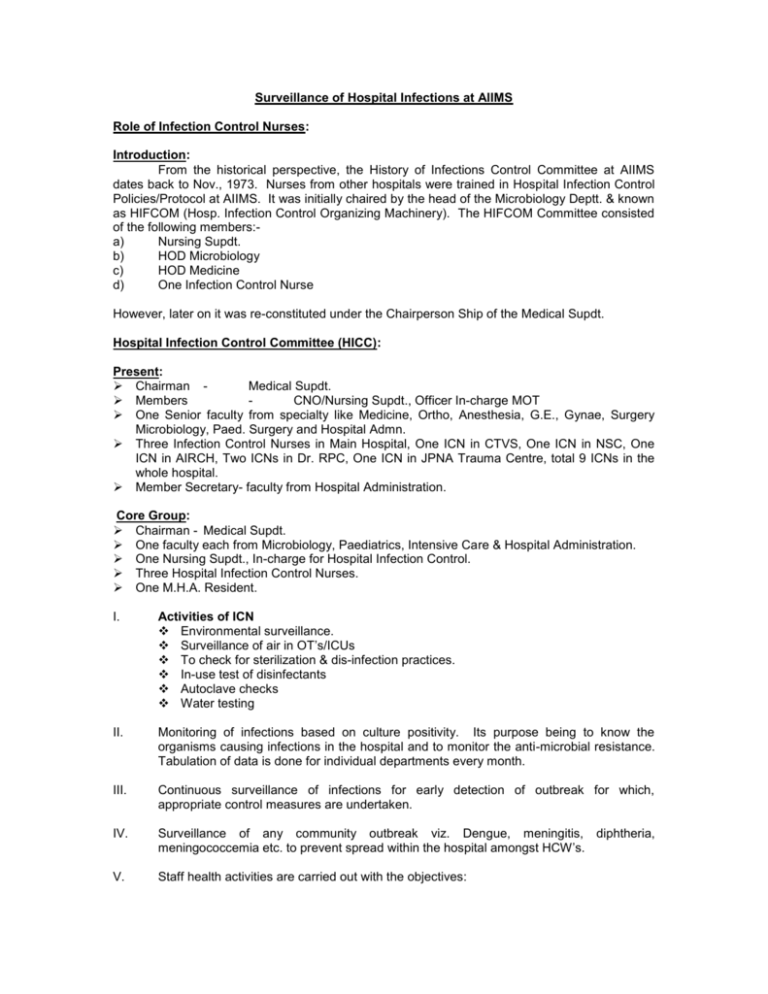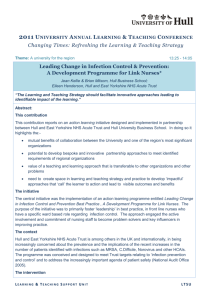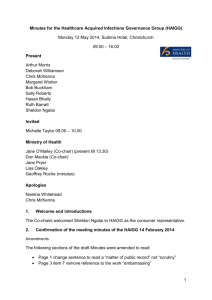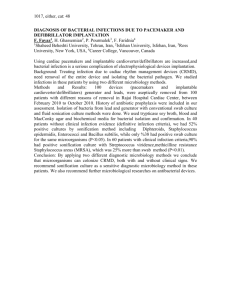Surveillance of Hosp. Infections at AIIMS
advertisement

Surveillance of Hospital Infections at AIIMS Role of Infection Control Nurses: Introduction: From the historical perspective, the History of Infections Control Committee at AIIMS dates back to Nov., 1973. Nurses from other hospitals were trained in Hospital Infection Control Policies/Protocol at AIIMS. It was initially chaired by the head of the Microbiology Deptt. & known as HIFCOM (Hosp. Infection Control Organizing Machinery). The HIFCOM Committee consisted of the following members:a) Nursing Supdt. b) HOD Microbiology c) HOD Medicine d) One Infection Control Nurse However, later on it was re-constituted under the Chairperson Ship of the Medical Supdt. Hospital Infection Control Committee (HICC): Present: Chairman Medical Supdt. Members CNO/Nursing Supdt., Officer In-charge MOT One Senior faculty from specialty like Medicine, Ortho, Anesthesia, G.E., Gynae, Surgery Microbiology, Paed. Surgery and Hospital Admn. Three Infection Control Nurses in Main Hospital, One ICN in CTVS, One ICN in NSC, One ICN in AIRCH, Two ICNs in Dr. RPC, One ICN in JPNA Trauma Centre, total 9 ICNs in the whole hospital. Member Secretary- faculty from Hospital Administration. Core Group: Chairman - Medical Supdt. One faculty each from Microbiology, Paediatrics, Intensive Care & Hospital Administration. One Nursing Supdt., In-charge for Hospital Infection Control. Three Hospital Infection Control Nurses. One M.H.A. Resident. I. Activities of ICN Environmental surveillance. Surveillance of air in OT’s/ICUs To check for sterilization & dis-infection practices. In-use test of disinfectants Autoclave checks Water testing II. Monitoring of infections based on culture positivity. Its purpose being to know the organisms causing infections in the hospital and to monitor the anti-microbial resistance. Tabulation of data is done for individual departments every month. III. Continuous surveillance of infections for early detection of outbreak for which, appropriate control measures are undertaken. IV. Surveillance of any community outbreak viz. Dengue, meningitis, diphtheria, meningococcemia etc. to prevent spread within the hospital amongst HCW’s. V. Staff health activities are carried out with the objectives: Educating personnel about the Principles of Infection Control and stressing individual responsibility for Infection Control. Collaborating with the infection control team in monitoring and investigating potentially harmful infectious exposures and outbreaks among personnel. Providing care to personnel for work related illnesses or exposures. Continuous training and on going education is carried out for freshly recruited residents, nurses and sanitation staff. Identifying work-related infection risks and instituting appropriate preventive measures. The goals are met by using vaccines optimally to prevent transmission of vaccine preventable diseases. Management of Job related illnesses and exposures is done by following the decisions on work restrictions as per the advice of the treating doctors. Records are maintained of all accidental HAI acquired by the staff with utmost confidentiality. VI. Advising HCS’s regarding terminal dis-infection of unit /Laundry, Proper Hospital Waste Management. Conclusion: The role of ICNs at the main hospital has: Contributed to a gradual decline over the years in the CIR at the AIIMS, Main Hospital. Helped the individual departments to formulate empirical antibiotic treatment strategies. Seen a cut in the cost of treating infections by the identification of impending outbreaks due to active surveillance indirectly. Helped in changing practices viz. A switch over to digital thermometers from clinical thermometers, using distilled H2O ampoules to dissolve injections rather than using common stock solutions, wet mopping over dry sweeping, using ecoshield for fumigation over the use of formaldehyde etc. Have helped in changing attitudes of HCW’s over the years and have made them more sensitive towards the infection control policies and protocols at AIIMS. Inspite of increased antimicrobial resistance Increased number of ICU’s / HDU’s Increase in number of transplant patients admitted in the hospital, the infection rate has continued to be the same meeting the International standards. Average length of stay of patients in the hospital has declined from 5.9 in 1997-98 to 4.8 in 2006-07.







